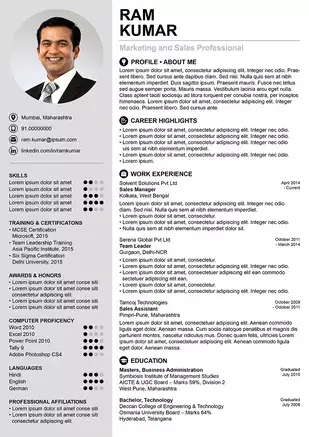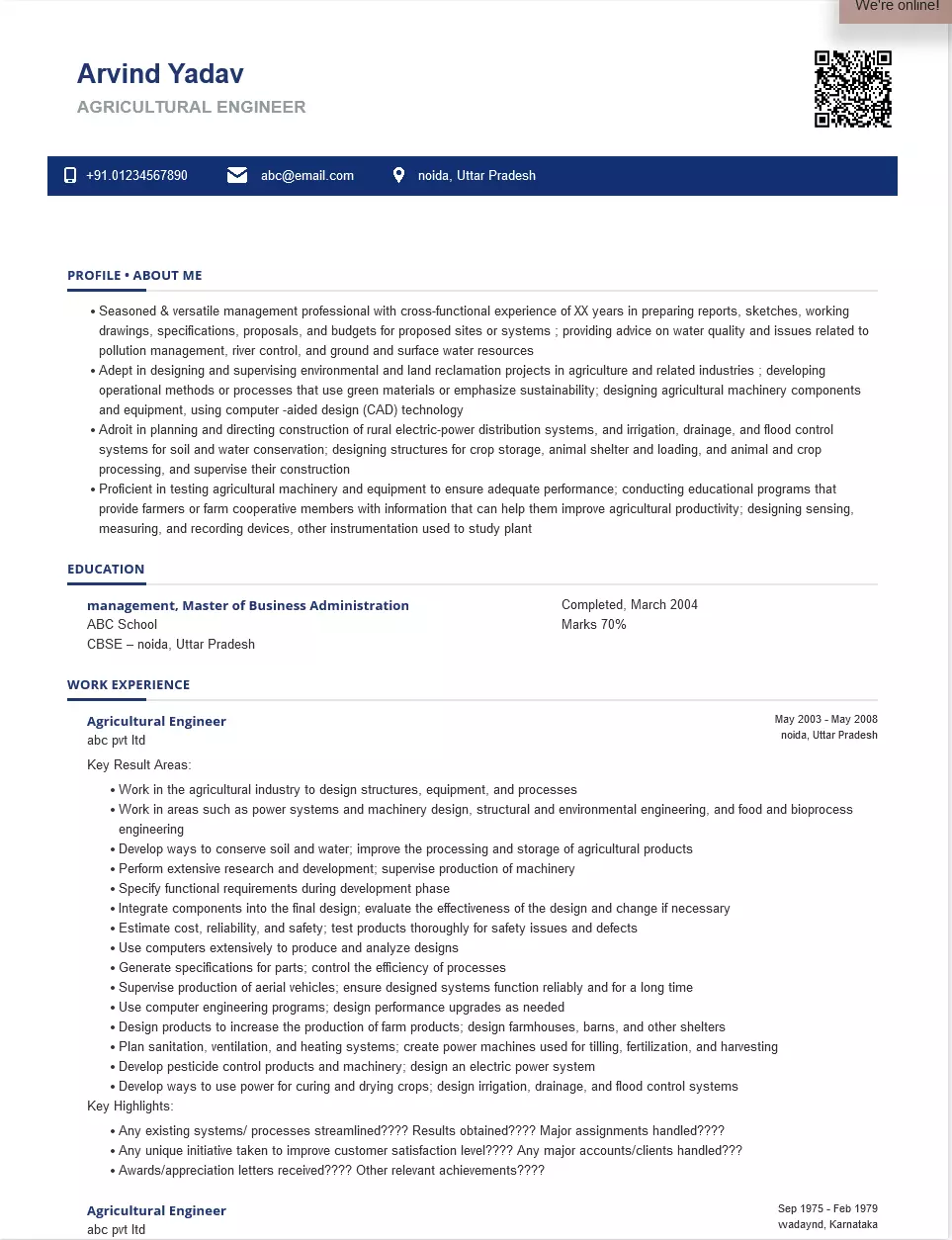- Accredited Agricultural Consultant, Completed , January 2012
What's your job?
Agricultural Engineer Resume Samples and Templates for 2026
- Table of Contents
- Downloadable Sample
- Resume Tips from Experts
- Resume Text Version
- Share
Agricultural Engineer Resume Guide for India
A well-crafted Agricultural Engineer resume is essential for success in India’s growing agricultural technology and farm mechanization sector. Whether you’re a fresher completing your B.Tech/M.Tech in Agricultural Engineering or an experienced professional seeking positions at ICAR, agricultural machinery companies, or agri-tech startups, this guide provides everything you need to create a standout resume that impresses Indian employers and passes ATS screening on portals like Naukri and LinkedIn.
This comprehensive guide includes:
- Resume format recommendations for Indian agricultural sector
- Key skills Indian employers look for
- Complete resume example with Indian context
- Top agricultural engineer employers in India
- Salary insights in INR by experience level
- Certification guidance for the Indian market
- ATS optimization tips for Indian job portals
Why Your Agricultural Engineer Resume Matters in India
India’s agricultural sector is undergoing rapid transformation with focus on farm mechanization, precision agriculture, and sustainable farming practices. Organizations like ICAR, IARI, Mahindra Tractors, TAFE (Tractors and Farm Equipment), John Deere India, Escorts Limited, Sonalika Tractors, and agri-tech startups like DeHaat, AgriNext, and CropIn actively hire agricultural engineers. A strong resume helps you:
- Stand out from thousands of engineering graduates on Naukri and LinkedIn
- Pass ATS screening used by agricultural companies and research institutions
- Showcase skills that Indian hiring managers value, including farm machinery design, irrigation systems, and precision agriculture
- Demonstrate your technical expertise and understanding of Indian farming conditions
Indian agricultural recruiters typically spend 6-10 seconds reviewing each resume initially. Your Agricultural Engineer resume must immediately communicate your technical knowledge, project experience, and relevant certifications. With India’s focus on doubling farmer income and agricultural modernization, a well-optimized resume is essential.
Agricultural Engineer Resume Format for India
Indian employers prefer clean, professional resume formats. Here’s what works best:
Recommended Format
- Length: 1-2 pages (freshers: 1 page, experienced: 2 pages max)
- Layout: Reverse chronological (most recent first)
- Font: Arial, Calibri, or Times New Roman (11-12pt)
- Sections: Contact, Summary, Skills, Experience, Education, Certifications
Resume vs Biodata
In India, use a professional resume format for private sector roles. “Biodata” format may be used for government and ICAR recruitment through ASRB.
Personal Details for Indian Agricultural Engineer Resumes
Indian resumes typically include:
- Full name
- Phone number with country code (+91)
- Professional email address
- LinkedIn profile URL
- City, State (full address not required)
- ICAR-AIEEA/GATE Score (if applicable for research positions)
What to Avoid
- Decorative fonts or graphics (causes ATS issues)
- Personal information like religion, caste, or father’s name
- Salary expectations (discuss during interview)
- References (provide when requested)
Key Skills for Agricultural Engineers in India
Indian employers look for comprehensive agricultural engineering skills covering farm machinery, irrigation, and post-harvest technology.
Farm Machinery & Equipment
- Tractor Design: Engine systems, transmission, hydraulics
- Farm Implements: Ploughs, harrows, seed drills, harvesters
- Equipment Testing: Performance testing, field trials
- Manufacturing: Fabrication, quality control
- Maintenance: Preventive maintenance, troubleshooting
Irrigation & Water Management
- Irrigation Systems: Drip, sprinkler, micro-irrigation
- Pump Design: Centrifugal pumps, submersible pumps
- Water Conservation: Rainwater harvesting, watershed management
- Canal Systems: Design, flow measurement
- Soil & Water Engineering: Soil conservation, drainage systems
Post-Harvest Technology
- Food Processing: Grain milling, oil extraction
- Storage Systems: Warehouse design, cold storage
- Drying Technology: Solar dryers, mechanical dryers
- Packaging: Food packaging systems
- Quality Control: Moisture content, grading systems
Precision Agriculture
- GPS & GIS: Farm mapping, variable rate technology
- Remote Sensing: Crop monitoring, yield estimation
- Farm Management Software: Data analysis, decision support
- IoT in Agriculture: Sensors, automated systems
- Drone Technology: Agricultural drones, spraying systems
Soft Skills for Indian Agricultural Engineering
- Problem-Solving: Addressing farmer challenges
- Communication: Training farmers, extension work
- Field Work: Willingness to work in rural areas
- Project Management: Managing agricultural projects
How to Present Skills
Create a dedicated skills section. Group by category (Farm Machinery, Irrigation, Post-Harvest). Highlight CAD software and certifications.
Agricultural Engineer Resume Example for India
Here’s a complete resume example tailored for Indian employers:
Suresh Kumar Patel
Bhopal, Madhya Pradesh | +91-98XXX-XXXXX | suresh.patel.agri@email.com | linkedin.com/in/sureshpatel-agri
GATE Score: 485 (AIR 1250) | Agricultural Engineering | 2019
Professional Summary
Results-driven Agricultural Engineer with 6+ years of experience in farm machinery design, irrigation systems, and precision agriculture. Expertise in tractor implement design, micro-irrigation systems, and post-harvest technology with proven track record of developing cost-effective solutions for Indian farmers. Proficient in AutoCAD, SolidWorks, and GIS applications. Strong background in field testing and farmer training programs. Seeking senior engineer position to contribute to India’s agricultural mechanization goals.
Skills
Farm Machinery: Tractor Design, Implement Design, Field Testing, Manufacturing, Quality Control Irrigation Systems: Drip Irrigation, Sprinkler Systems, Pump Design, Water Management Post-Harvest: Grain Processing, Storage Systems, Drying Technology, Cold Storage Precision Agriculture: GPS/GIS Applications, Remote Sensing, Farm Management Software Software: AutoCAD, SolidWorks, MATLAB, ArcGIS, MS Office
Professional Experience
Senior Agricultural Engineer | Mahindra & Mahindra (Farm Equipment Sector) | Nagpur | April 2021 – Present
- Design and develop tractor-mounted implements for Indian farming conditions
- Conduct field testing of new implements across different soil types and crops
- Collaborate with R&D team for product improvement based on farmer feedback
- Train dealers and farmers on proper equipment usage and maintenance
- Reduce implement manufacturing cost by 12% through design optimization
- Achieve successful launch of 3 new implements for smallholder farmers
- Coordinate with ICAR institutes for technology validation
Agricultural Engineer | Jain Irrigation Systems | Jalgaon | June 2018 – March 2021
- Designed micro-irrigation systems for horticulture and field crops
- Conducted site surveys and prepared irrigation layouts for farmers
- Managed installation projects across Maharashtra and Madhya Pradesh
- Trained farmers on drip irrigation operation and maintenance
- Achieved 95% customer satisfaction rating
- Processed 200+ irrigation projects annually
Junior Engineer | ICAR-CIAE (Central Institute of Agricultural Engineering) | Bhopal | July 2017 – May 2018
- Assisted in research projects on farm mechanization
- Conducted field trials for prototype testing
- Prepared technical reports and research documentation
- Participated in Kisan Mela demonstrations
- Gained exposure to ICAR research protocols
Key Achievements
Cost-Effective Implement Design | Mahindra | 2023
- Developed low-cost rotavator for small tractors (15-30 HP)
- Optimized design for small and marginal farmers
- Result: 12% cost reduction, 25% increase in sales, farmer appreciation
Irrigation Project Excellence | Jain Irrigation | 2020
- Managed large-scale drip irrigation project for pomegranate orchards
- Covered 500+ hectares across 200 farmers in Solapur district
- Result: 40% water savings, 20% yield improvement, PMKSY recognition
Research Contribution | ICAR-CIAE | 2018
- Contributed to development of solar-powered sprayer
- Conducted field trials in tribal areas of MP
- Result: Technology adopted by 50+ farmers, presented at national conference
Education
Master of Technology (M.Tech) | IIT Kharagpur | 2017
- Specialization: Agricultural & Food Engineering
- CGPA: 8.4/10
- Thesis: Design and Performance Evaluation of Precision Seed Drill
Bachelor of Technology (B.Tech) | Jawaharlal Nehru Krishi Vishwavidyalaya (JNKVV) | Jabalpur | 2015
- Agricultural Engineering
- CGPA: 8.6/10
- Final Year Project: Solar-Powered Irrigation Pump Design
Certifications
- Precision Agriculture Technology | NAARM Hyderabad | 2022
- AutoCAD Professional Certification | Autodesk | 2020
- Drip Irrigation Design | Jain Irrigation Academy | 2019
- GIS for Agriculture | ESRI India | 2021
- Farm Machinery Testing | CIAE Bhopal | 2018
Professional Memberships
- Life Member, Indian Society of Agricultural Engineers (ISAE)
- Member, Institution of Engineers India (IEI) - Agricultural Division
- Associate Member, Society of Automotive Engineers India (SAEINDIA)
Publications
- “Performance Evaluation of Precision Seed Drill for Soybean” - Journal of Agricultural Engineering, ISAE, 2020
- “Solar-Powered Sprayer for Small Farmers” - CIAE Annual Conference, 2018
Languages
English (Fluent) | Hindi (Native) | Marathi (Conversational)
Declaration
I hereby declare that the information provided above is true to the best of my knowledge.
Suresh Kumar Patel Bhopal, December 2024
Top Agricultural Engineer Employers in India
India’s agricultural sector offers diverse opportunities. Here are the top employers:
Tractor & Farm Equipment Companies
- Mahindra & Mahindra: India’s largest tractor manufacturer
- TAFE (Tractors and Farm Equipment): Massey Ferguson brand
- Escorts Limited: Farmtrac and Powertrac tractors
- Sonalika Tractors: Leading tractor brand
- John Deere India: Global agricultural equipment
- CNH Industrial: New Holland, Case IH brands
- VST Tillers: Power tillers and tractors
Irrigation Companies
- Jain Irrigation Systems: Micro-irrigation leader
- Netafim India: Drip irrigation specialist
- Rivulis India: Irrigation solutions
- Finolex Plasson: PVC pipes and fittings
- Mahindra EPC Irrigation: Turnkey irrigation projects
Research Institutions (ICAR)
- ICAR-CIAE: Central Institute of Agricultural Engineering, Bhopal
- ICAR-IARI: Indian Agricultural Research Institute, Delhi
- ICAR-CIPHET: Post-harvest engineering, Ludhiana
- State Agricultural Universities: Multiple across India
- KVKs (Krishi Vigyan Kendras): Extension work
Agri-Tech Startups
- DeHaat: Farm inputs and advisory
- CropIn: Farm management platform
- Ninjacart: Agri supply chain
- AgriNext: Smart farming solutions
- Fasal: Precision agriculture
- SatSure: Satellite-based farm analytics
Food Processing Companies
- ITC Agri Business: Integrated agribusiness
- Cargill India: Agricultural trading
- Bühler India: Food processing equipment
- Allana Group: Food processing
- NDDB (National Dairy Development Board): Dairy technology
How to Apply
- Apply through Naukri.com and LinkedIn
- ICAR recruitment through ASRB (Agricultural Scientists Recruitment Board)
- Company career pages directly
- Campus placements from agricultural universities
- Agricultural job portals (Agriculturejob.co.in)
Agricultural Engineer Salary in India
Agricultural engineering offers stable career growth. Salaries vary based on sector, experience, and location.
Salary by Experience Level
| Experience | Private Sector (INR) | ICAR/Research (INR) |
|---|---|---|
| Fresher (0-2 years) | ₹3.5 - ₹6 LPA | ₹5 - ₹8 LPA |
| Junior (2-5 years) | ₹6 - ₹10 LPA | ₹8 - ₹12 LPA |
| Mid-Level (5-10 years) | ₹10 - ₹18 LPA | ₹12 - ₹20 LPA |
| Senior (10-15 years) | ₹18 - ₹30 LPA | ₹20 - ₹30 LPA |
| Management (15+ years) | ₹30 - ₹50 LPA | ₹30 - ₹45 LPA |
Note: ICAR positions offer additional benefits including housing, medical, and pension.
Salary by City/Region
| Location | Salary Range (Mid-Level) |
|---|---|
| Pune | ₹12 - ₹20 LPA |
| Delhi NCR | ₹11 - ₹18 LPA |
| Nagpur | ₹10 - ₹16 LPA |
| Hyderabad | ₹10 - ₹16 LPA |
| Bhopal | ₹9 - ₹14 LPA |
| Ludhiana | ₹9 - ₹15 LPA |
Factors Affecting Salary
- Sector: Tractor companies typically pay highest
- Company Type: MNCs like John Deere pay premium
- GATE Score: Important for ICAR and PSU positions
- Specialization: Precision agriculture commands premium
- Location: Urban R&D centers pay more than field positions
- Education: IIT/IARI graduates typically start higher
Salary data based on Glassdoor India, AmbitionBox, and agricultural industry surveys.
Certifications for Agricultural Engineers in India
Professional certifications enhance your employability and career growth.
Technical Certifications
- AutoCAD/SolidWorks Certification: Design software
- GIS Certification: ESRI, IIRS courses
- Precision Agriculture: NAARM, MANAGE courses
- Farm Machinery Testing: CIAE, FMTTIs
Irrigation & Water Management
- Drip Irrigation Design: Jain Irrigation, Netafim training
- Watershed Management: NIRD courses
- Water Quality Testing: CPCB certification
- Pump Selection & Design: Industry courses
Post-Harvest Technology
- Food Processing Technology: CFTRI courses
- Cold Chain Management: NCCD certification
- Warehouse Management: Industry certifications
- Quality Control: FSSAI related courses
Professional Development
- ISAE Courses: Indian Society of Agricultural Engineers
- NAARM Training: Agricultural research management
- MANAGE Programs: Extension management
- Online Courses: Coursera, edX agricultural engineering
How to List Certifications
Include certification name, issuing body, and year. Technical certifications should be prominently displayed.
ATS Tips for Your Agricultural Engineer Resume
Most companies use Applicant Tracking Systems (ATS) to screen resumes. Optimize yours:
For Naukri.com
- Use keywords from job descriptions (agricultural engineer, farm machinery, irrigation)
- Keep formatting simple (no tables, columns, or graphics)
- Use standard section headings (Experience, Education, Skills)
- Upload in .docx or .pdf format
- Update profile regularly
For LinkedIn Applications
- Match resume to LinkedIn profile
- Use standard job titles (Agricultural Engineer, Farm Equipment Engineer, Irrigation Engineer)
- Include GATE score for research positions
- Get endorsements for technical skills
General ATS Tips
- DO: Standard fonts, clear headings, bullet points
- DO: Include metrics (12% cost reduction, 200+ projects, 40% water savings)
- DO: Mention specific software and certifications
- DON’T: Use headers/footers, text boxes, images
- DON’T: Use creative section titles
Keyword Strategy for Agricultural Engineer Roles
Common keywords from job postings:
- Agricultural Engineer, Farm Equipment Engineer, Irrigation Engineer
- Tractor Design, Implement Design, Farm Machinery
- Drip Irrigation, Sprinkler Systems, Water Management
- AutoCAD, SolidWorks, GIS, GPS
- Post-Harvest, Food Processing, Cold Storage
- Precision Agriculture, Farm Mechanization
Final Tips for Your Agricultural Engineer Resume
✅ Include GATE score—important for ICAR and research positions
✅ Quantify achievements (12% cost reduction, 200+ projects, 40% water savings)
✅ Show farm machinery expertise—design, testing, manufacturing
✅ Highlight irrigation experience—drip, sprinkler systems
✅ Include CAD proficiency—AutoCAD, SolidWorks essential
✅ Show field work experience—farmer interaction, demonstrations
✅ Professional presentation—error-free and well-organized
Quick Checklist
- Contact with +91 phone and LinkedIn
- GATE score (if applicable for research positions)
- Professional summary with agricultural engineering highlights
- Skills organized by category (Machinery, Irrigation, Post-Harvest)
- Experience showing projects and achievements
- Education with CGPA/percentage
- Certifications (software, technical, irrigation)
- Professional memberships (ISAE, IEI)
- ATS-friendly formatting
- Declaration statement
Ready to create your professional Agricultural Engineer resume? Use our resume builder to get started with expert-designed templates optimized for Indian job portals.
For more guidance on resume structure, check out our resume format guide with tips specifically for the Indian agricultural engineering job market.
Agricultural Engineer Text-Only Resume Templates and Samples
Arvind Yadav
Phone: 01234567890
Email: abc@email.com
Address: sec-44, Noida, noida
About Me
AGRICULTURAL ENGINEER
- An Experienced Agricultural Engineer- Applying knowledge of engineering technology and biological science to agricultural problems concerned with power and machinery, electrification, structures, soil and water conservation, and processing of agricultural products
- Seasoned & versatile management professional with cross-functional experience of XX years in preparing reports, sketches, working drawings, specifications, proposals, and budgets for proposed sites or systems; providing advice on water quality and issues related to pollution management, river control, and ground and surface water resources
- Adept in designing and supervising environmental and land reclamation projects in agriculture and related industries; developing operational methods or processes that use green materials or emphasize sustainability; designing agricultural machinery components and equipment, using computer-aided design (CAD) technology
- Adroit in planning and directing the construction of rural electric-power distribution systems, and irrigation, drainage, and flood control systems for soil and water conservation; designing structures for crop storage, animal shelter and loading, and animal and crop processing, and supervising their construction
- Proficient in testing agricultural machinery and equipment to ensure adequate performance; conducting educational programs that provide farmers or farm cooperative members with information that can help them improve agricultural productivity; designing sensing, measuring, and recording devices, and other instrumentation used to study plant
Education
Agriculture, Bachelor of Engineering / Bachelor of Technology, Completed, March 2004
Mahatma Phule Krishi Vidyapeeth
– Marks 70
Rahuri, MH
Certifications
Work Experience
Period: May 2017 - Current
Agricultural Engineer / Service Engineer
Meera Cleanfuels Limited
- Work in the agricultural industry to design structures, equipment, and processes
- Work in areas such as power systems and machinery design, structural and environmental engineering, and food and bioprocess engineering
- Develop ways to conserve soil and water; improve the processing and storage of agricultural products
- Perform extensive research and development; supervise the production of machinery
- Specify functional requirements during the development phase
- Integrate components into the final design; evaluate the effectiveness of the design and change if necessary
- Estimate cost, reliability, and safety; test products thoroughly for safety issues and defects
- Use computers extensively to produce and analyze designs
- Generate specifications for parts; control the efficiency of processes
- Supervise production of aerial vehicles; ensure designed systems function reliably and for a long time
- Use computer engineering programs; design performance upgrades as needed
- Design products to increase the production of farm products; design farmhouses, barns, and other shelters
- Plan sanitation, ventilation, and heating systems; create power machines used for tilling, fertilization, and harvesting
- Develop pesticide control products and machinery; design an electric power system
- Develop ways to use power for curing and drying crops; design irrigation, drainage, and flood control systems
Period: September 2008 - February 2011
Agricultural Engineer
Aries Agro Ltd
- Designed agricultural machinery components and equipment, using computer-aided design (CAD) technology
- Tested agricultural machinery and equipment to ensure that they perform properly
- Designed food-processing plants and supervise manufacturing operations
- Planned and directed the construction of rural electric-power distribution systems
- Designed structures to store and process crops
- Designed housing and environments to maximize animals’ comfort, health, and productivity
- Provide advice on water quality and issues related to managing pollution, controlling rivers, and protecting and using other water resources
- Designed and supervised environmental and land reclamation projects in agriculture and related industries
- Discussed plans with clients, contractors, consultants, and other engineers so that the plans can be evaluated and any necessary changes made
Skills
- Complex problem-solving
- Knowledge of engineering science and technology
- Design skills and knowledge
- Attention to detail
- Analytical thinking
- Concentration
- Teamwork
- Persistence
- Determination
- Communication
Languages
Softwares
Operating System
Personal Interests
- Plants and Nature
- Yoga
- Traveling
 India's
premier resume service
India's
premier resume service





